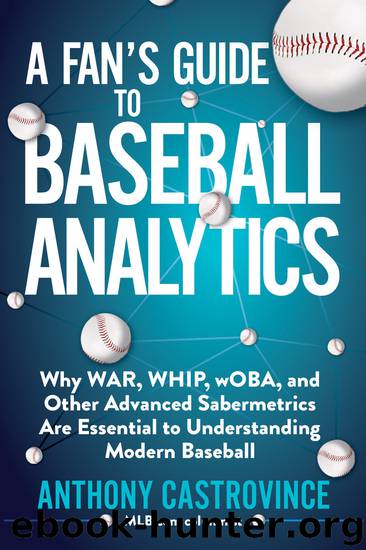A Fan's Guide to Baseball Analytics by Anthony Castrovince;

Author:Anthony Castrovince;
Language: eng
Format: epub
ISBN: 9781683583455
Publisher: Simon & Schuster
Published: 2020-04-29T16:00:00+00:00
Rating
Game Score
Make Sure Your Friends Are Watching
90–100
Excellent
80–90
Great
70–80
Good
60–70
Above Average
50–60
Below Average
40–50
Poor
30–40
Bad
20–30
Awful
10–20
Unspeakable
0–10
The vast majority of seasons produce at least 10 performances that rate as a 90 or higher. The 2015 season had 31 of them—the most in a single season since the advent of the designated hitter rule in 1973. But as pitching roles continue to (d)evolve and starters don’t go as deep into games, the 90+ score could become something of an endangered species.
Of course, because those games in which the starter simply doesn’t have it will always crop up, poor scores are a part of the picture. Back in 2006, there were a record 13 instances in which pitchers posted a GSc of zero or below. St. Louis Cardinals right-hander Jason Marquis had two starts that season in which he gave up double-digit run and hit totals in only five innings of work, so he has the rare distinction of two sub-zero Game Scores (more like Game Sores) in a single season. There have been 30 major-league seasons in which the entire league didn’t register more than one such outing.
The lowest GSc on record for a nine-inning game belongs to Hod Lisenbee. On September 11, 1936, Lisenbee, pitching for the Philadelphia A’s, allowed 17 runs (14 earned) on a record-tying 26 hits with four walks and only one strikeout against the Chicago White Sox. That’s a calamitous -35 on the GSc scale. But in Lisenbee’s defense, he was thrown to the wolves that day. A’s manager Connie Mack had opted to minimize the number of pitchers he brought on a road trip, and it was up to the 37-year-old Lisenbee to go the distance no matter what. And the “what,” in this instance, was ugly.
So how seriously should we take Game Score? James didn’t intend for it to be more than a diversion, and the formula has some flaws. Hit batsmen, such as the one Wood plunked in his famous game, don’t count, and there is no differentiation between intentional walks issued by a manager and walks that are more attributable to pitching performance. Furthermore, there is no differentiation between types of hits. And comparing Game Scores—much like ERAs—across eras can be misleading, depending on the offensive environment a pitcher is working in.
But GSc can be used in aggregate to give a snapshot of a season, or even a career. In the live ball era (beginning in 1920), Sandy Koufax’s 1963 season featured the most “great” (GSc of 70 or above) starts, with 28. Koufax won the Cy Young and the NL MVP that year. According to the research from Scott Lindholm of the analysis website BeyondtheBoxScore.com, Nolan Ryan has the highest cumulative GSc (46,262) in history, which speaks to his incredible longevity. Pedro Martínez (61.2), Bob Gibson (61.0), and Tom Seaver (60.3) have the three highest career Game Score averages among those with at least 400 starts, which speaks to their day-to-day dominance.
Most importantly, GSc does a much better job contextualizing a performance than the oft-cited Quality Start stat.
A Quality
Download
A Fan's Guide to Baseball Analytics by Anthony Castrovince;.epub
This site does not store any files on its server. We only index and link to content provided by other sites. Please contact the content providers to delete copyright contents if any and email us, we'll remove relevant links or contents immediately.
Periodization Training for Sports by Tudor Bompa(7324)
The MacArthur Bible Commentary by John MacArthur(4231)
The Body: A Guide for Occupants by Bill Bryson(3791)
The Sports Rules Book by Human Kinetics(3582)
What It Really Takes to Get Into Ivy League and Other Highly Selective Colleges by Hughes Chuck(3217)
Marijuana Grower's Handbook by Ed Rosenthal(3114)
The Sprouting Book by Ann Wigmore(3050)
Salt, Fat, Acid, Heat: Mastering the Elements of Good Cooking by Nosrat Samin(2653)
The Martian by Andy Weir(2604)
Classic by Mary Berry(2499)
The Bread Bible by Rose Levy Beranbaum(2467)
Harry Potter 4 - Harry Potter and The Goblet of Fire by J.K.Rowling(2413)
The Marketing Plan Handbook: Develop Big-Picture Marketing Plans for Pennies on the Dollar by Robert W. Bly(2408)
Sapiens and Homo Deus by Yuval Noah Harari(2406)
Martha Stewart's Baking Handbook by Martha Stewart(2328)
50 Economics Classics by Tom Butler-Bowdon(2063)
Screenplay: The Foundations of Screenwriting by Syd Field(2052)
The Cambridge Grammar Of The English Language by Rodney Huddleston Geoffrey K. Pullum(2043)
The Plant Paradox by Dr. Steven R. Gundry M.D(2036)
